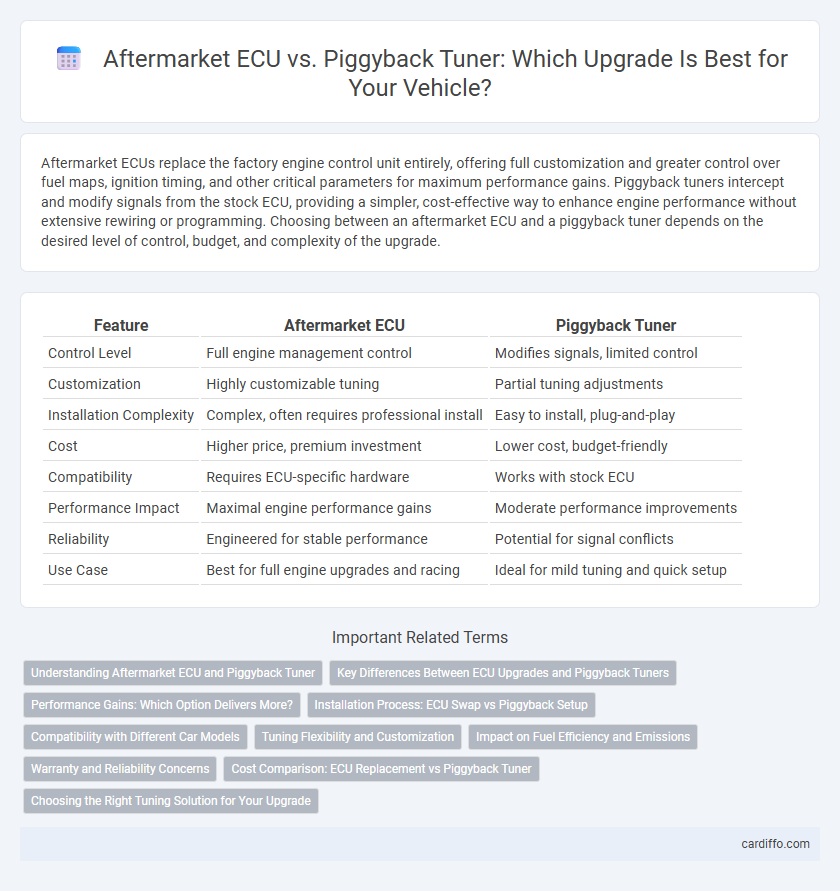Aftermarket ECUs replace the factory engine control unit entirely, offering full customization and greater control over fuel maps, ignition timing, and other critical parameters for maximum performance gains. Piggyback tuners intercept and modify signals from the stock ECU, providing a simpler, cost-effective way to enhance engine performance without extensive rewiring or programming. Choosing between an aftermarket ECU and a piggyback tuner depends on the desired level of control, budget, and complexity of the upgrade.
Table of Comparison
| Feature | Aftermarket ECU | Piggyback Tuner |
|---|---|---|
| Control Level | Full engine management control | Modifies signals, limited control |
| Customization | Highly customizable tuning | Partial tuning adjustments |
| Installation Complexity | Complex, often requires professional install | Easy to install, plug-and-play |
| Cost | Higher price, premium investment | Lower cost, budget-friendly |
| Compatibility | Requires ECU-specific hardware | Works with stock ECU |
| Performance Impact | Maximal engine performance gains | Moderate performance improvements |
| Reliability | Engineered for stable performance | Potential for signal conflicts |
| Use Case | Best for full engine upgrades and racing | Ideal for mild tuning and quick setup |
Understanding Aftermarket ECU and Piggyback Tuner
Aftermarket ECU and piggyback tuners both optimize engine performance but differ in integration and control scope. An aftermarket ECU fully replaces the stock unit, offering extensive tuning capabilities and customization for fuel maps, ignition timing, and boost control. Piggyback tuners modify specific sensor signals to adjust performance parameters without replacing the factory ECU, making them easier to install but less comprehensive in fine-tuning.
Key Differences Between ECU Upgrades and Piggyback Tuners
ECU upgrades involve replacing or reprogramming the vehicle's original engine control unit to fully optimize engine performance, offering comprehensive control over fuel mapping, ignition timing, and boost pressure. Piggyback tuners, by contrast, intercept and modify sensor signals to adjust engine parameters without altering the stock ECU, providing a less invasive and often more affordable performance enhancement. ECU upgrades generally deliver more precise tuning, greater customization options, and compatibility with a wider range of modifications compared to the limited adjustments achievable with piggyback tuners.
Performance Gains: Which Option Delivers More?
Aftermarket ECUs offer superior performance gains by providing full control over fuel mapping, ignition timing, and boost levels, enabling precise engine optimization for significant horsepower and torque increases. Piggyback tuners modify signals to the stock ECU without full engine management, typically resulting in moderate performance improvements with easier installation and lower cost. For maximum power output and comprehensive tuning capabilities, aftermarket ECUs deliver more substantial performance enhancements than piggyback systems.
Installation Process: ECU Swap vs Piggyback Setup
Aftermarket ECU swaps require a complete replacement of the vehicle's factory engine control unit, demanding extensive wiring modifications and precise calibration for optimal performance, often necessitating professional installation. Piggyback tuners, by contrast, install alongside the stock ECU and intercept sensor signals, offering a less invasive setup with plug-and-play compatibility that reduces installation time and maintains factory ECU integrity. Choosing between the two depends on the vehicle's make and model, desired tuning flexibility, and the installer's technical expertise.
Compatibility with Different Car Models
Aftermarket ECUs offer enhanced compatibility with a wide range of car models by providing complete control over engine parameters and allowing customized maps tailored to specific vehicles. Piggyback tuners, while generally easier to install, often have limited compatibility and may not support all model-specific sensors or systems, restricting their effectiveness on certain cars. Choosing an aftermarket ECU ensures deeper integration and adaptability, especially for performance upgrades on diverse vehicle platforms.
Tuning Flexibility and Customization
Aftermarket ECUs offer superior tuning flexibility by allowing full control over engine parameters such as fuel maps, ignition timing, and boost levels, enabling precise customization for specific performance goals. Piggyback tuners modify sensor signals to adjust engine functions but provide limited adjustments compared to standalone ECUs, restricting deep engine management customization. Enthusiasts seeking extensive tuning capabilities and adaptability prefer aftermarket ECUs for their ability to support advanced modifications and complex setups.
Impact on Fuel Efficiency and Emissions
Aftermarket ECU upgrades offer direct control over fuel mapping and ignition timing, leading to significant improvements in fuel efficiency and reduced emissions by optimizing engine performance more precisely than piggyback tuners. Piggyback tuners adjust sensor signals but cannot fully override factory ECU parameters, resulting in more limited fuel economy gains and less effective emissions control. Choosing an aftermarket ECU is ideal for maximizing environmental benefits and achieving stricter emission standards in performance upgrades.
Warranty and Reliability Concerns
Aftermarket ECUs often require complete engine management replacement, potentially voiding manufacturer warranties due to extensive modifications. Piggyback tuners work alongside the stock ECU to adjust performance parameters without altering the factory system, preserving warranty coverage and reducing risk. Reliability is higher with piggyback systems since they retain original ECU functions, whereas standalone ECU swaps depend heavily on proper installation and tuning quality.
Cost Comparison: ECU Replacement vs Piggyback Tuner
Replacing an aftermarket ECU typically involves higher upfront costs, ranging from $800 to $2,500, but offers full engine control and advanced tuning capabilities. Piggyback tuners generally cost between $300 and $700, serving as a more budget-friendly option for modifying engine parameters without replacing the stock ECU. The cost difference reflects the extent of control, customization potential, and installation complexity between ECU replacement and piggyback tuning solutions.
Choosing the Right Tuning Solution for Your Upgrade
When selecting the ideal tuning solution for your upgrade, an aftermarket ECU offers comprehensive control over engine parameters, enabling precise customization for performance gains and reliability. Piggyback tuners provide an easier installation process by modifying sensor signals without replacing the stock ECU, making them a cost-effective choice for moderate enhancements. Evaluating your vehicle's tuning goals, complexity, and budget ensures the right balance between flexibility and convenience in optimizing engine performance.
aftermarket ECU vs piggyback tuner Infographic

 cardiffo.com
cardiffo.com